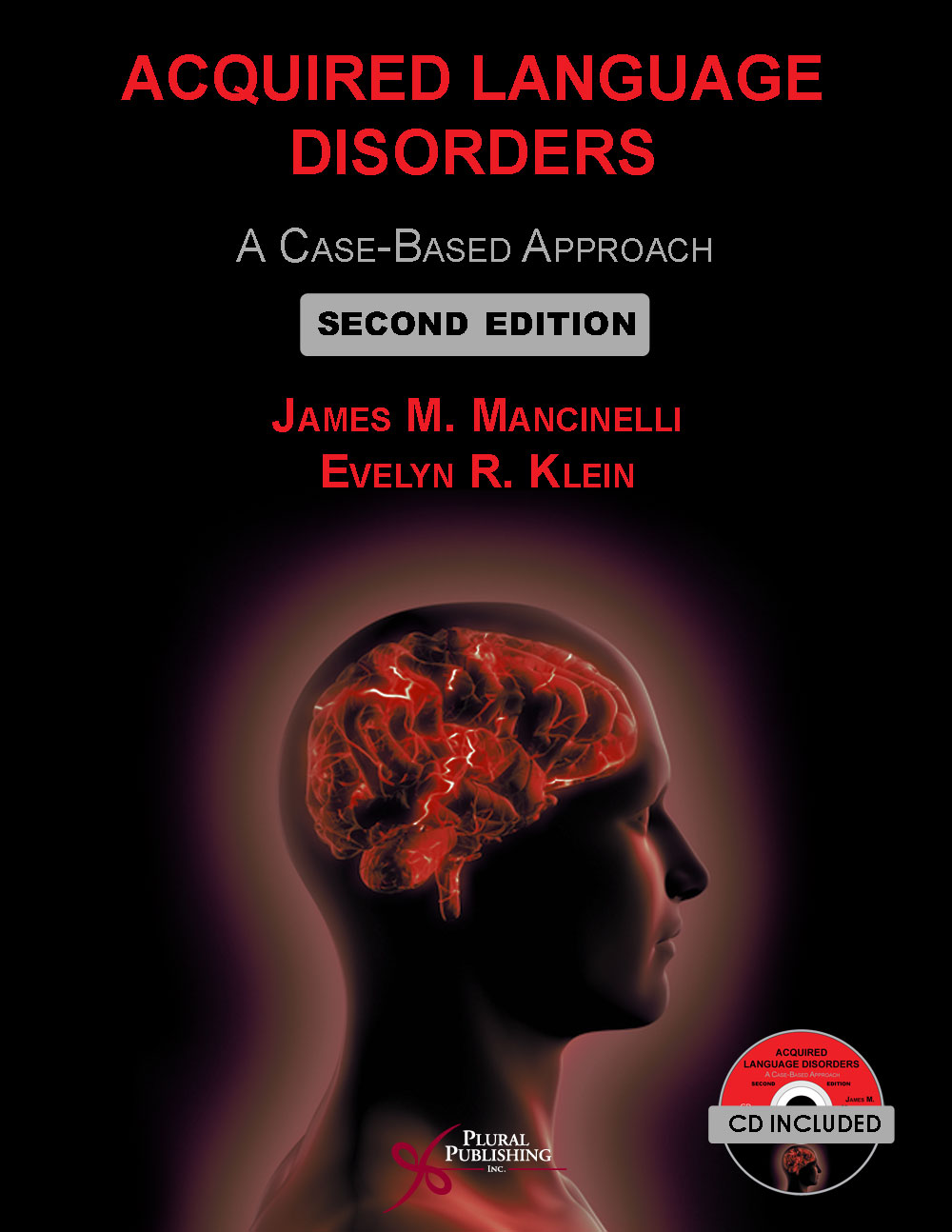
Acquired Language Disorders: A Case-Based Approach..
Second Edition
James M. Mancinelli, Evelyn R. Klein
Details: 312 pages, B&W, Softcover + CD, 8.5" x 11"
ISBN13: 978-1-59756-571-4
© 2014 | Available
A new edition of this text will be released in December.
Acquired Language Disorders: A Case-Based Approach, now in its second edition, is a practical, easy-to-follow, informative guide for students and clinicians. The authors present each case from a holistic perspective, encouraging clinicians to consider executive functions, attention, memory, and visuospatial skills of the person with aphasia during the assessment process and throughout treatment.
This edition begins with a review of the basics of brain-behavior relationships and pertinent medical terminology for treating individuals who have a neurological impairment. Each disorder is then introduced in a case-based format with a Target Model that includes a diagnostic profile along with treatment considerations and a functional analysis of the case.
New to the Second Edition
- Current therapeutic information and strategies with a review of recent research pertaining to individuals with acquired language disorders and individuals with cognitive communication deficits secondary to mild brain injury
- Resources for cognitive assessments of people with aphasia, and new directions and interventions for patients with dementia
- Twenty-three treatment programs including 11 new approaches such as Speech Entrainment; A Program for Phonological Alexia/Agraphia; Oral Reading for Language in Aphasia with Virtual Therapist (ORLA-VT); and more
- Discussion of innovative approaches for treating aphasia such as Repeated Transcranial Magnetic Stimulation (rTMS); Anodal Transcranial Direct Current Stimulation (A-tDCS); and Cathodal Transcranial Direct Current Stimulation (C-tDCS)
- A "Test Your Knowledge" section with questions based on 10 patient scenarios that instructors can also use as a professional discussion tool
- Color inserts and a Quick Reference Diagnostic Chart for Acquired Language Disorders (ALD) that addresses and provides diagnostic information for the major nonfluent and fluent aphasias as well as other ALDs.
- A sample, completed Functional Communications Connections Worksheet included in the color insert and a blank version included in the appendix for treatment planning purposes
- An accompanying CD with updated PowerPoint slides to complement other pedagogical materials
By providing a variety of ALD patient cases along with critical thinking activities for students and a review for clinicians, Acquired Language Disorders: A Case-Based Approach, Second Edition demonstrates its relevance in both the classroom and clinical settings.
Reviews
"This book endeavours to cater for all. It reviews neuroanatomy and neurophysiology, assessment methods and treatment approaches for aphasia, right hemisphere disorders, TBI, dementia and encephalopathy. The final chapter considers how the assessment and treatment of acquired language disorders will develop, including discussion about bio/pharmacological treatments and AAC.
The authors make an avid effort to bridge the gap between theory and practice. The examples given include a description of the client, a functional analysis, pointers for critical thinking, treatment considerations and discussion about appropriate therapeutic methods. What we liked about the examples is that they have not overlooked factors, such as cognition and family/carer implications. ..."
—Laura Wrangles and Kate Mackay, Adult SLTs, Hertfordshire Community NHS Trust, Royal College of Speech & Language Therapists (2014)
"Acquired Language Disorder: A Case-based Approach could not be more relevant considering the current and future states of healthcare in our country. Healthcare reform calls us to practice based on evidence, produce clinically significant changes as a result of the care we deliver and reserves payment for the right therapy, in the right dose, by the right professional in the right setting. A case-based approach provides clinicians with that evidence."
—Garry Pezzano, MS/CCC-SLP, Senior Vice President of Clinical Practice Genesis Rehab Services
Preface
Acknowledgments
Chapter 1. An Overview of Neuroanatomy and Neurophysiology Related to Acquired Language Disorders (ALD)
- The Neuron
- Neurotransmitters
- The Brain: A Brief Review of Structures and Functions
- The Coverings of the Brain, Ventricles, and Cerebrospinal Fluid
- Cerebral Cortex
- The Brainstem
- Subcortical Structures
- The Cerebellum
- Neural Pathways
- Cerebral Blood Flow
- Cerebrovascular Accidents
- Brain Imaging and Selected Medical Tests for Acquired Language Disorders
- CAT Scan or CT Scan
- MRI
- fMRI
- PET Scan
- SPECT Scan
- ASL
- Examination of the Carotids: Doppler Ultrasound or Audculation of the Carotids
- Endocardiography
- Angiography
- References
Chapter 2. Elements of Assessment in Acquired Language Disorders
- Assessment
- Areas of Language Function
- Characteristics of Major Aphasic Syndromes
- Definitions of the Clinical Characteristics of the Major Aphasic Syndromes
- Extralinguistic and Paralinguistic Consideration in Assessment
- Types of Assessment
- Functional Assessment
- Bedside Assessment
- Cognition, Aphasia, and the ALD Target Model
- The Target Model and Cognitive Assessment in Acquired Language Disorders
- Modifications to Standard Approaches to Assessment
- Use of Standardized Tests for Individuals with Cognitive-Communication Disorders
- Commonly Used Assessments for Acquired Language Disorders:
- Arizona Battery for Communication Disorders of Dementia
- Addenbrooke's Cognitive Examination
- Assessment of Language-Related Functional Activities
- Mini Mental State Exam
- Global Deterioration Scale
- Boston Diagnostic Aphasia Examination-3
- Burns Brief Inventory of Communication and Cognition
- Cognitive Linguistic Evaluation
- Cognitive Linguistic Quick Test
- Coma Recovery Scale-Revised
- Comprehensive Aphasia Test
- Communication Activities of Daily Living, Second Edition
- The Kentucky Aphasia Test
- Psycholinguistic Assessments of Language Processing in Aphasia
- Reading Comprehension Battery for Aphasia
- Ross Information Processing Assessment-2
- The Scales of Cognitive and Communicative Ability for Neurorehabilitation
- Scales of Cognitive Ability for Traumatic Brain Injury
- Western Aphasia Battery-Revised
- Selected Assessments for Aphasia by Category
- Comprehensive Language Batteries
- Functional Tests of Communication
- Tests Bases on a Cognitive Neuropsychological Model
- Tests Examining Specific Areas of Language Performance
- Treatment and Goal Setting
- Documentation of Progress
- Service Delivery to People with Acquired Language Disorders
- The Acute Care Setting
- The Rehabilitation Setting
- The Home Care Setting
- The Outpatient Setting
- The Long-Term Care Setting
- Summary
- References
- Appendix 2-A. Quick Reference Diagnostic Chart for Acquire Language Disorders
- Appendix 2-B. Functional Communication Connections
Chapter 3. The Major Nonfluent Aphasias
- Introduction
- Brocas Type Aphasia
- Characteristics
- A Functional Case Analysis of Maurice
- Critical Thinking/Learning Activity
- Treatment Considerations
- Some Therapeutic Options
- Transcortical Motor Aphasia
- Characteristics
- Functional Case Analysis of Vincent
- Critical Thinking/Learning Activity
- Treatment Considerations
- Some Therapeutic Options
- Global Aphasia
- Characteristics
- A Functional Case Analysis for Elizabeth
- Critical Thinking/Learning Activity
- Treatment Considerations
- Some Therapeutic Options
- References
Chapter 4. The Fluent Aphasias
- Introduction
- Wernickes Type Aphasia
- Characteristics
- A Functional Case Analysis of Mildred's Wernicke's Aphasia
- Critical Thinking/Learning Activity
- Treatment Considerations
- Some Therapeutic Options
- Transcortical Sensory Aphasia (TSA)
- Characteristics
- A Functional Case Analysis of John's TSA
- Critical Thinking/Learning Activity
- Treatment Considerations
- Some Therapeutic Options
- References
Chapter 5. Other Aphasic Syndromes
- Subcortical Aphasia
- Introduction
- Characteristics of the Subcortical Aphasias
- A Functional Case Analysis of Winnie's Subcortical Aphasia
- Critical Thinking/Learning Activity
- Treatment Considerations
- Some Therapeutic Options
- Primary Progressive Aphasia
- Introduction
- Characteristics
- A Functional Case Analysis of Luis's Primary Progressive Aphasia
- Critical Thinking/Learning Activity
- Treatment Considerations
- Some Therapeutic Options
- Acquired Alexia and Agraphia
- Characteristics
- A Functional Case Analysis of Sue's Alexia
- Critical Thinking/Learning Activity
- Treatment Considerations
- Some Therapeutic Options
- References
Chapter 6. Right Hemisphere Disorder
- Introduction
- Characteristics
- RHD and Pragmatic Impairment
- Visual-Perceptual Deficits
- Visuomotor Deficits
- Auditory Perceptual Deficits
- Cognitive Deficits
- A Functional Case Analysis of Debra
- Critical Thinking/Learning Activity
- Treatment Considerations
- Some Therapeutic Options
- References
Chapter 7. Traumatic Brain Injury
- Introduction
- Characteristics
- Types of Brain Injury
- Symptoms Related to Localization of the TBI
- Prognostic Consideration in Head Injury
- Premorbid Intelligence
- Age at the Time of Injury
- Duration of Coma
- Posttraumatic Seizures
- Hydrocephalus
- Spasticity
- Cognitive-Linguistic Impairment Due to TBI
- Establishing Goals for the Theraputic Course
- Postconcussive Syndrome
- Mild TBI
- Rating Scales for Functional Outcomes
- A note about Generalization in People with TBI
- A Functional Analysis of Samuel's TBI
- Critical Thinking/Learning Activity
- Treatment Considerations
- Therapeutic Options
- References
Chapter 8. Dementia
- Introduction
- Characteristics
- Diagnostic Factors
- Stages of Dementia
- Memory Systems and Dementia
- Types of Dementia
- Vascular Dementia
- Parkinson's Dementia
- Fronto-Temporal-Parietal Dementias
- Creutzfielt-Jakob Disease
- Huntingon's Disease
- Overview of Research on Treatment for Dementia
- A Functional Case Analysis of Max's Dementia
- Critical Thinking/Learning Activity
- Treatment Considerations
- Some Therapeutic Options
- References
Chapter 9. Encephalopathy
- Introduction
- Characteristics
- Drug and Alcohol Intoxication
- A Functional Case Analysis of Tommy
- Critical Thinking/Learning Activity
- Treatment Considerations
- Some Therapeutic Options
- References
Chapter 10. Past, Present and Future Considerations in Acquired Language Disorders
- Historical Overview of Efficacy and Evidence in the Treatment of Acquired Language Disorders in Adults
- Randomized Controlled Trials and Aphasia Treatment
- Treatment Approaches and Future Trends
- Biological and Pharmacologic Interventions
- Intensity of Treatment
- Computer-Assisted Technology and Treatment of Aphasia
- AAC for Adults with ALD: Aphasia, Primary Progressive Aphasia, TBI, and Dementia
- The Use of Applications (Apps) in the Rehabilitation of the ALD Patient
- The Use of Video Games in the Rehabilitation of the ALD Patient
- References
Appendix A. Case History Form
- Background Information
- Health and Medical History
- Educational History
- Psychosocial and Family History
Appendix B. Skills Assessment Inventory
- How to Use the SAI
Appendix C. Cognitive-Linguistic Evaluation
Appendix D. Selected Treatment Programs and Approaches
- A Treatment Sequence for Phonological Alexia/Agraphia
- Anagram, Copy, and Recall Therapy
- Concurrent Treatment for Reading and Spelling in Aphasia
- Constraint-Induced Language Therapy
- Divergent Word Retrieval
- Life Participation Approach to Aphasia
- Lingraphica
- Mapping Treatment
- Melodic Intonation Therapy
- MossTalk Words
- Narrative Story Cards
- Nonsymbolic Movements for Activation of Intention
- Normal Sentence Production
- Oral Reading for Language in Aphasia with Virtual Therapist
- Promoting Aphasics Communicative Effectiveness
- Response Elaboration Training
- Schuells Stimulation Approach
- Semantic Feature Analysis
- Sentence Production Program for Aphasia
- Sentence Shaper
- Speech Entrainment
- Treatment of Underlying Forms
- Visual Action Therapy
Appendix E. The World Health Organization and the International Classification of Functioning, Disability, and Health
- Body Functions and Structures
- Activities and Participation
- Contextual Factors (Environmental Factors and Personal Factors)
- The ICF and the Rehabilitation of the Person with an Acquire Language Disorder
- Reference
Appendix F. The Octagon Worksheet for Functional Communication
Appendix G. Test Your Knowledge
- Case #1
- Case #2
- Case #3
- Case #4
- Case #5
- Case #6
- Case #7
- Answer Key
Index
Accompanying PowerPoint slides and CD include lecture material for:
- Review of Neuroanatomy
- The Target Model
- Assessment in Acquired Language Disorders (ALD)
- Nonfluent Aphasia
- Fluent Aphasia
- Subcortical Aphasia
- Primary Progressive Aphasia (PPA)
- Acquired Dyslexia and Dysgraphia
- Right Hemisphere Disorder (RHD)
- Traumatic Brain Injury (TBI) and Post Concussive Syndrome (PCS)
- Dementia
- Encephalopathy
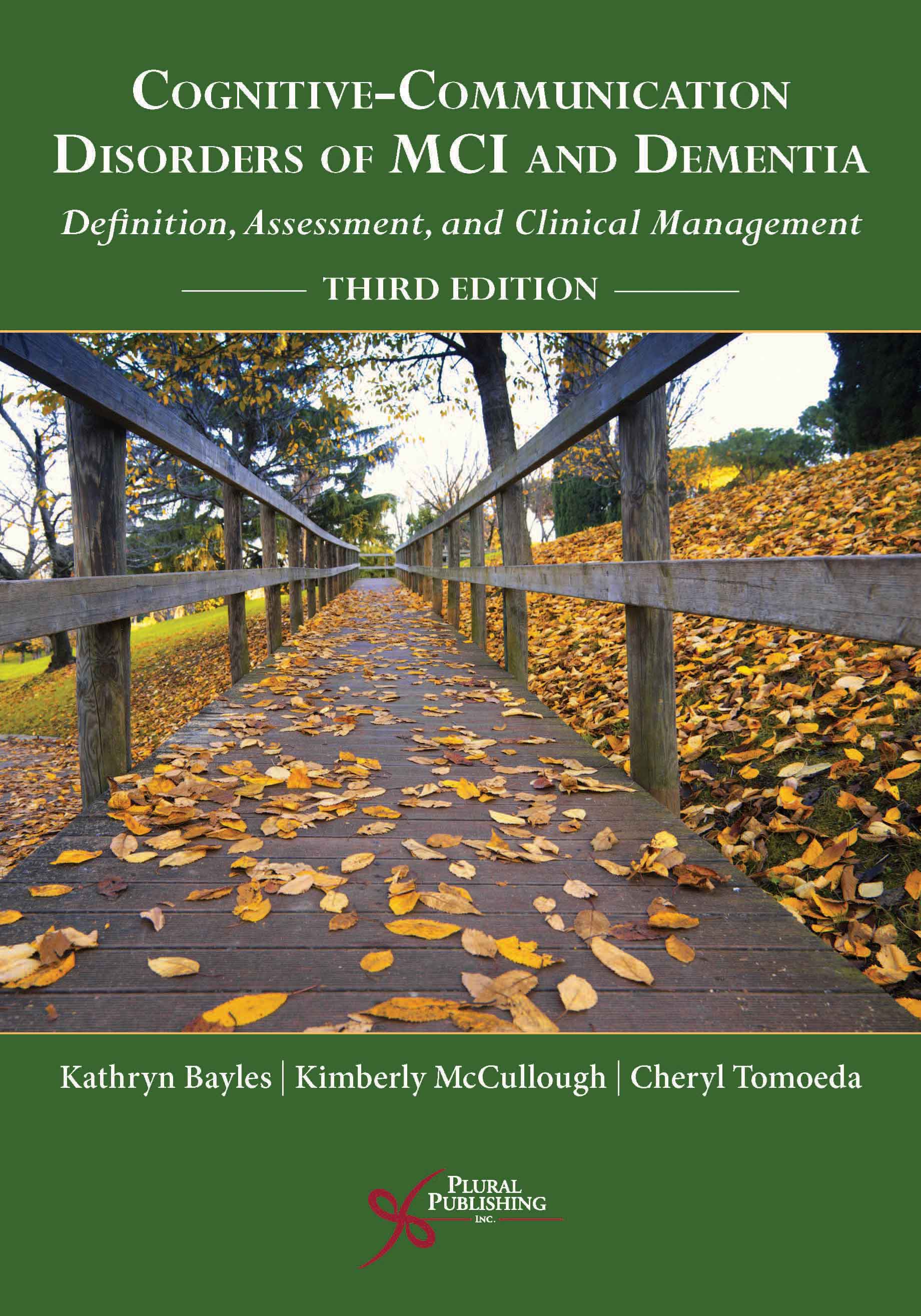
Cognitive-Communication Disorders of MCI and Dementia: Definition, Assessment, and Clinical Management
Third Edition
Kathryn Bayles, Kimberly McCullough, Cheryl K. Tomoeda
Details: 265 pages, B&W, Softcover, 7" x 10"
ISBN13: 978-1-63550-060-8
© 2020 | Available
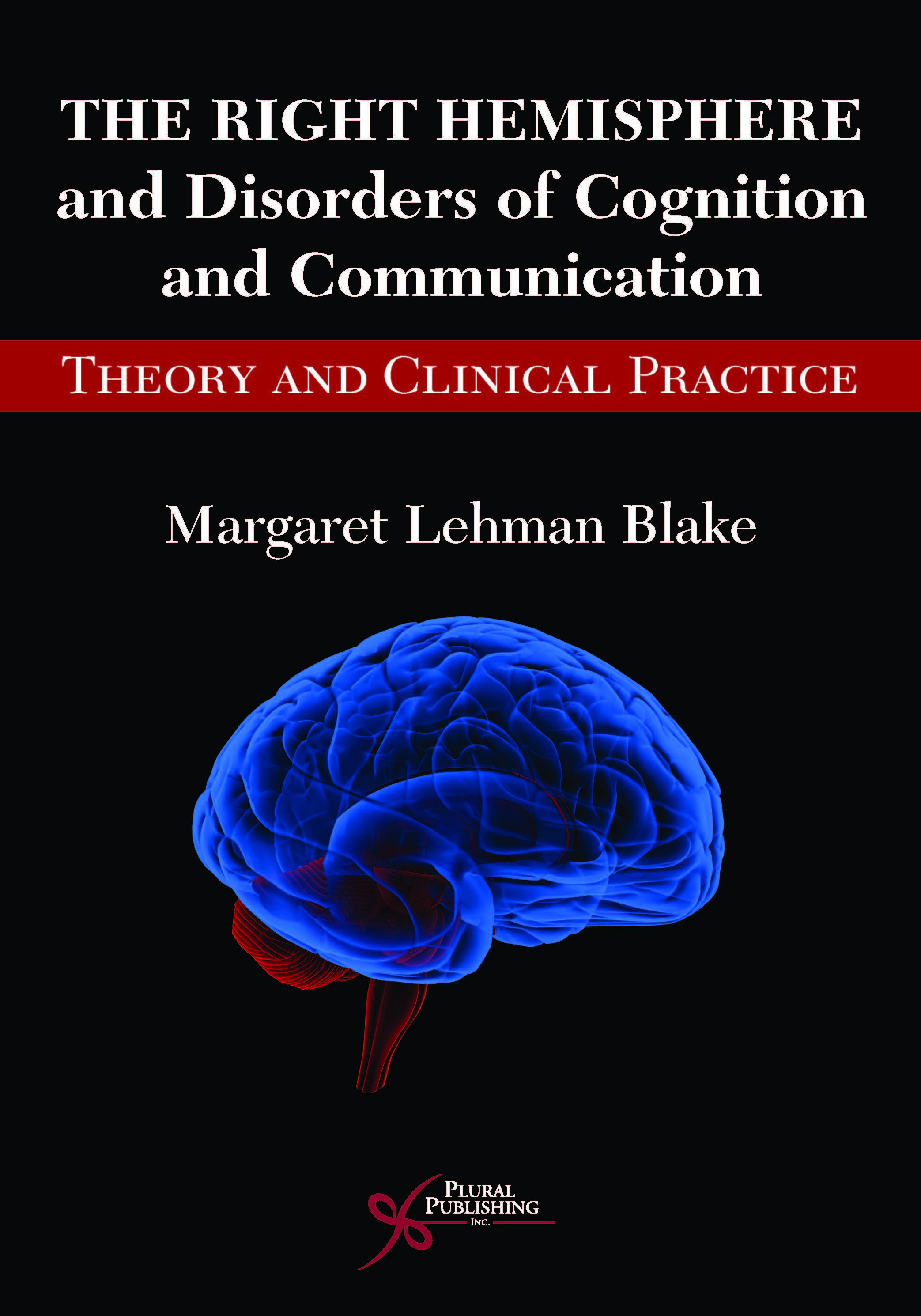
The Right Hemisphere and Disorders of Cognition and Communication: Theory and Clinical Practice
First Edition
Margaret Lehman Blake
Details: 301 pages, B&W, Softcover, 7" x 10"
ISBN13: 978-1-59756-962-0
© 2018 | Available
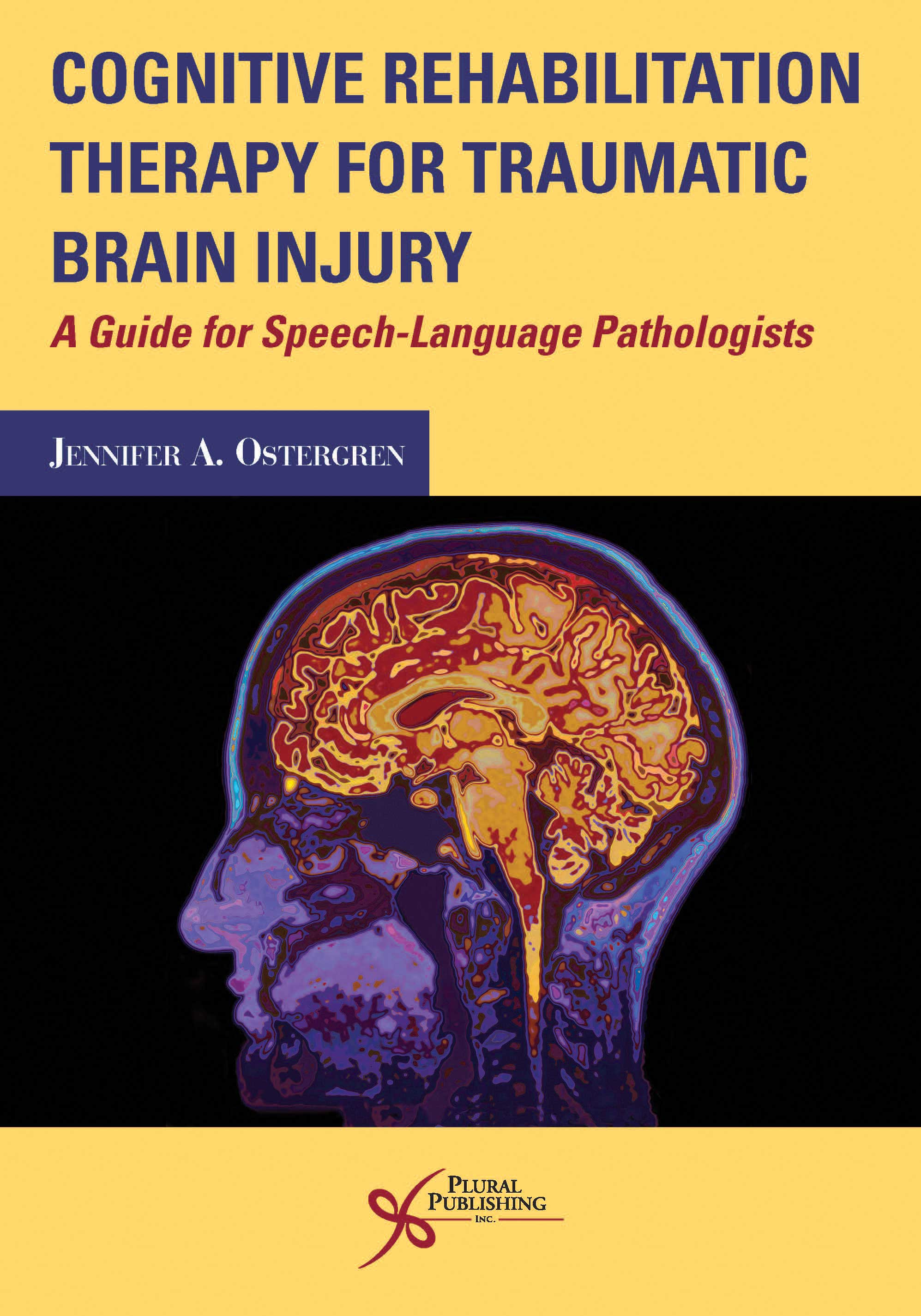
Cognitive Rehabilitation Therapy for Traumatic Brain Injury: A Guide for Speech-Language Pathologists
First Edition
Jennifer A. Ostergren
Details: 321 pages, B&W, Softcover, 7" x 10"
ISBN13: 978-1-59756-789-3
© 2018 | Available
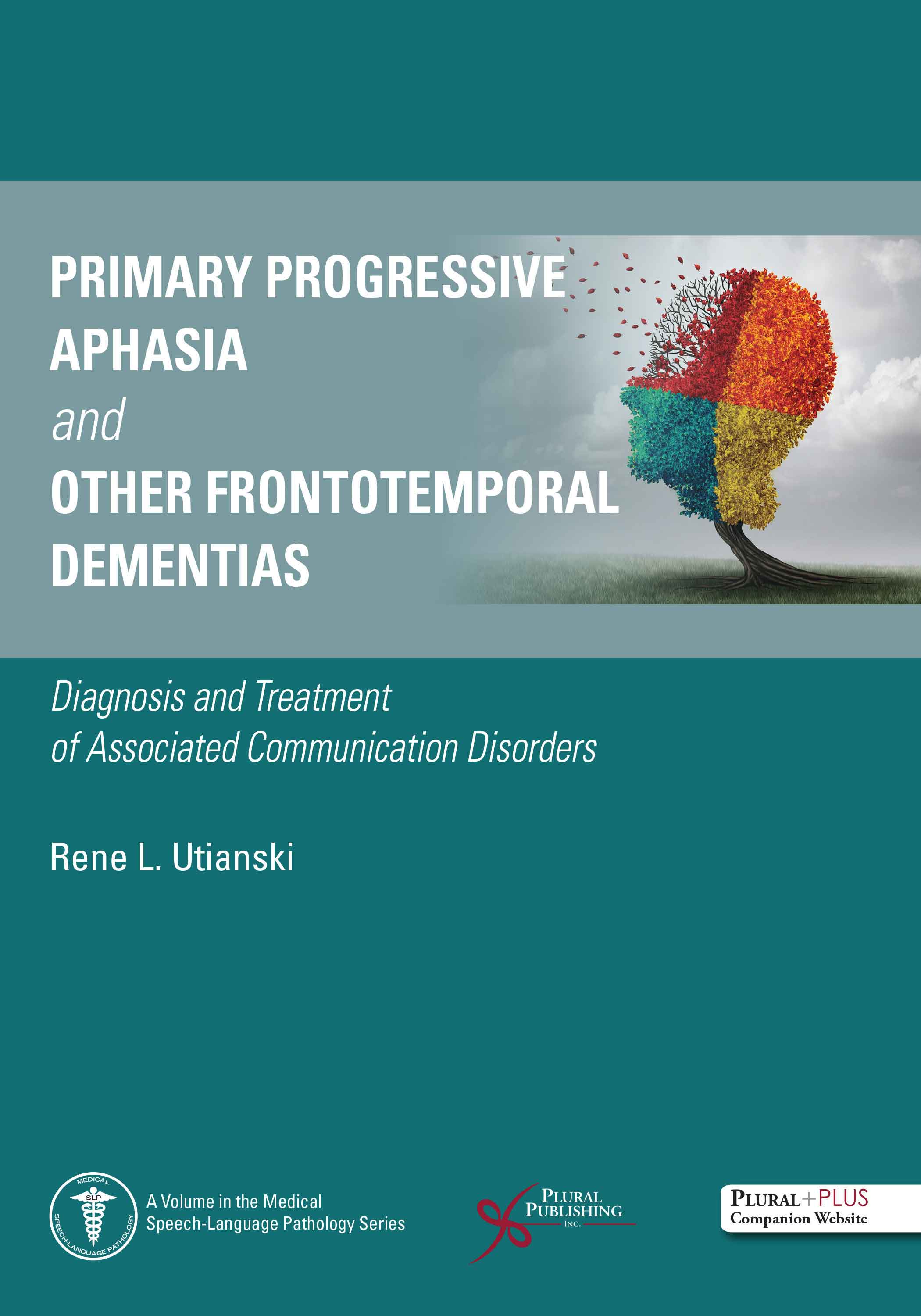
Primary Progressive Aphasia and Other Frontotemporal Dementias: Diagnosis and Treatment of Associated Communication Disorders
First Edition
Rene L. Utianski
Details: 188 pages, B&W, Softcover, 7" x 10"
ISBN13: 978-1-63550-160-5
© 2020 | Available
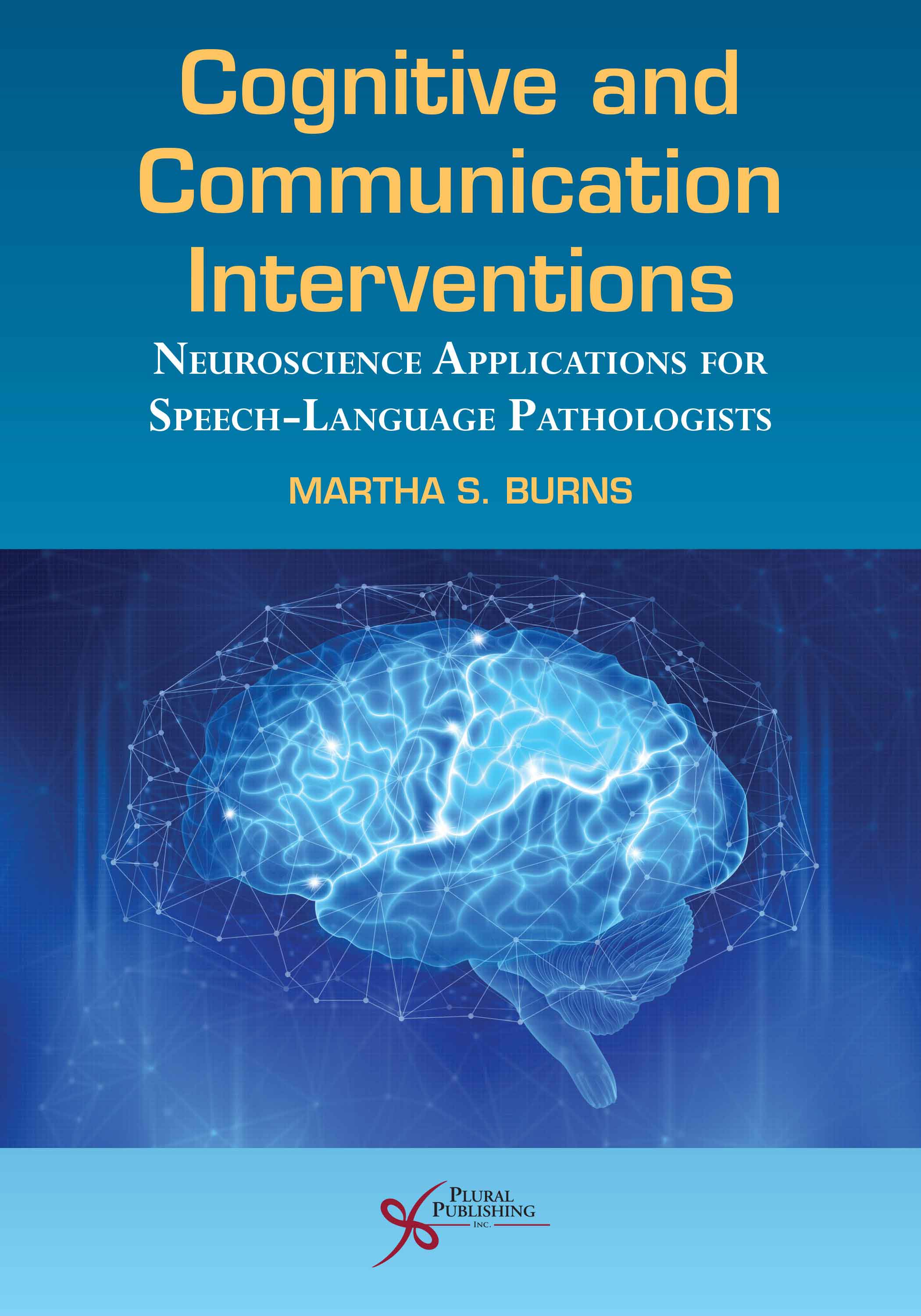
Cognitive and Communication Interventions: Neuroscience Applications for Speech-Language Pathologists
First Edition
Martha S. Burns
Details: 318 pages, B&W, Softcover, 7" x 10"
ISBN13: 978-1-63550-292-3
© 2021 | Available
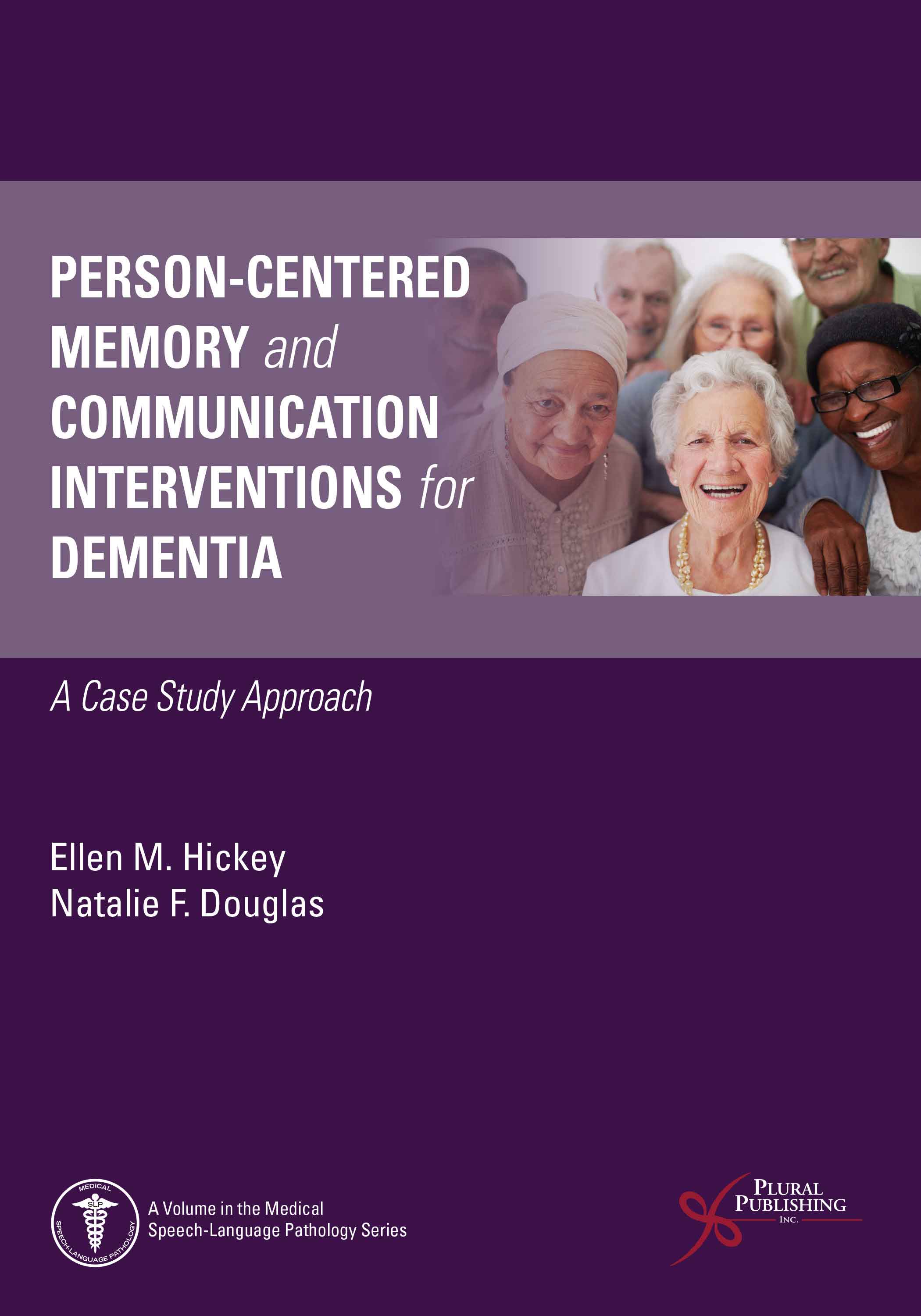
Person-Centered Memory and Communication Interventions for Dementia: A Case Study Approach
First Edition
Ellen M. Hickey, Natalie F. Douglas
Details: 178 pages, B&W, Softcover, 7" x 10"
ISBN13: 978-1-63550-301-2
© 2021 | Available


